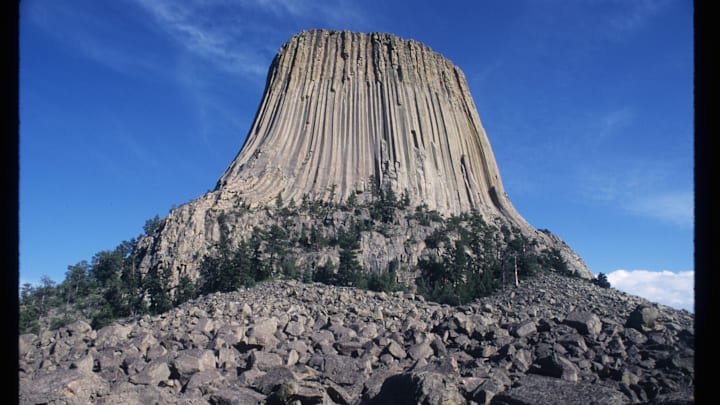Steven Spielberg fans are likely familiar with Devils Tower, even if they don’t know it by name. The dramatic butte—which towers 1267 feet above the plains of northeastern Wyoming and the Belle Fourche River—was famously featured in 1977’s Close Encounters of the Third Kind, culminating in a scene in which an alien mothership descended upon the rock formation.
In the nearly five decades since its release, the film has introduced several generations of fans to the natural landmark—whether they were watching it at home or at a special screening at the base of Devils Tower itself. That said, there’s a lot more to this natural wonder than what you’ve seen on the silver screen.
1. Devils Tower is sacred to many Native American tribes.
To the Northern Plains Indian Tribes, Devils Tower isn’t just a stunning landmark—it’s a sacred place. It appears in multiple oral histories and sacred narratives, and is also known by multiple ancient names.
For example, the Arapahoe call Devils Tower “Bear’s Tipi”; the Kiowa refer to it as “Aloft on a Rock” or “Tree Rock”; and the Lakota people know it as “Bear Lodge,” “Bear Lodge Butte,” “Grizzly Bear's Lodge,” “Mythic-owl Mountain,” “Grey Horn Butte,” and “Ghost Mountain.” However, it’s commonly referred to as “Mateo Tepee,” which is likely Sioux for “Bear Wigwam,” or “Bear Lodge.” (Long ago, the surrounding region was home to many bears.)
To this day, Devils Tower is frequently the site of ceremonial rituals, including sun dances, sweat lodges, and prayer and artifact offerings. (While visiting the park, make sure not to touch or move any religious artifacts.)
2. Its name is controversial.

Devils Tower received its popular English name in 1875, when Colonel Richard Irving Dodge led geologist Walter P. Jenney’s scientific expedition through the Black Hills region. They were there to confirm claims of gold, first initiated by General George Armstrong Custer. But when they arrived at the rock formation, they were overwhelmed by its natural beauty. Dodge described the landmark as “one of the most remarkable peaks in this or any country.”
Dodge recorded the butte’s name as “Devils Tower,” writing that the Natives “call this shaft The Bad God’s Tower, a name adopted with proper modification, by our surveyors.” But since so many Native names for the towering formation referenced a bear—plus, Native translations for “Bear Lodge” appeared on early maps of the region—it’s likely that Dodge’s expedition simply mistranslated the landmark’s name. (In the Lakota language, the bad god or evil spirit is called wakansica, and the word for black bear is wahanksica.)
In recent years, Native tribes have petitioned to officially change the name of Devils Tower to Bear Lodge, as they find the current moniker offensive. Meanwhile, other locals argue that changing the formation’s name would cause confusion and harm regional tourism.
3. Devils Tower was America’s very first national monument.
Devils Tower was the very first official United States National Monument. It was proclaimed by President Theodore Roosevelt—who famously loved the American West—on September 24, 1906, shortly after he signed the Antiquities Act into law. Roosevelt made Dodge’s translation the tower’s official name, but along the way, the apostrophe in “Devil’s Tower” was dropped due to a clerical error. The error was never corrected so, to this day, the tower is simply called “Devils Tower.”
4. It’s not a volcano.

Some claim that Devils Tower is an old volcano, but geologists say it’s likely an igneous intrusion, meaning it formed underground from molten rock, or magma, that pushed up into sedimentary rock and became solid. Over millions of years, the surrounding sedimentary rock eroded away to display the tall, grayish core within.
Experts estimate that the formation of Devils Tower occurred about 50 million years ago, whereas the erosion took place between 5 and 10 million years ago.
5. It’s not hollow.
Devils Tower is composed of a rock called phonolite porphyry, which is like a less sparkly granite, as it contains no quartz. And while it may appear hollow at a distance, the striated monument is actually solid. (The NPS compares it to “a bunch of pencils held together by gravity.”)
6. It’s really big.
Devils Tower isn’t just extremely tall—it’s also very wide. Its summit is around 180 feet by 300 feet—roughly the size of a football field—and the circumference of its base is around one mile.
7. It’s a famous rock-climbing destination.
Devils Tower is popular among rock climbing enthusiasts, who rely on its many parallel cracks to shimmy their way to the top. (Long before modern climbing equipment existed, local ranchers simply made do with a wooden ladder.) According to the National Park Service, Devils Tower sees between 5000 and 6000 rock climbers a year.
However, the site is closed to climbers each June, as Native American ceremonies are often held during and around the summer solstice. Additionally, some routes are closed each spring to protect nesting prairie or peregrine falcons.
A version of this story ran in 2017; it has been updated for 2023.
